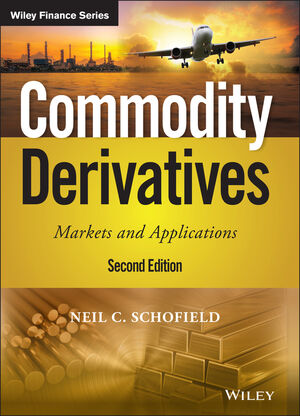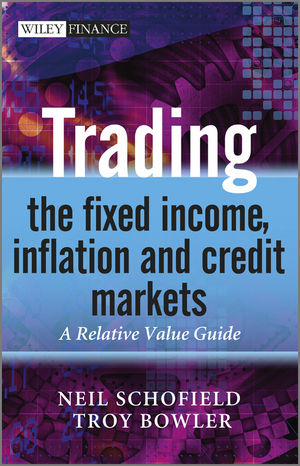Commodity derivatives
markets and applications
- ISBN: 9781119349105
- Editorial: John Wiley & Sons, Inc.
- Fecha de la edición: 2021
- Lugar de la edición: Hoboken (NJ). Estados Unidos de Norteamérica
- Edición número: 2nd ed.
- Colección: Wiley Finance Series
- Encuadernación: Cartoné
- Medidas: 24 cm
- Nº Pág.: 530
- Idiomas: Inglés

Commodity Derivatives
In the newly revised Second Edition of Commodity Derivatives: Markets and Applications, expert trading educator and author Neil Schofield delivers a comprehensive overview of a wide variety of commodities and derivatives. Beginning with discussions of commodity markets generally before moving on to derivative valuation and risk management, the author then dives into individual commodity markets, like gold, base metals, crude oil, natural gas, electricity, and more.
Schofield relies on his extensive experience at Barclays Investment Bank to offer readers detailed examinations of commodity finance and the use of commodities within a wider investment portfolio.
The second edition includes discussions of critical new topics like dual curve swap valuation, option valuation within a negative price environment using the Bachelier model, volatility skews, smiles, smirks, term structures for major commodities, and more. You’ll find case studies on corporate failures linked to improper commodity risk management, as well as explorations of issues like the impact of growing interest in electric vehicles on commodity markets.
The text of the original edition has been updated and expanded and new example transactions are included to help the reader understand the concepts discussed within. Each chapter follows a uniform structure, with typical demand and supply patterns following a non-technical description of the commodity at issue. Discussions of the physical markets in each commodity and the main exchange-traded and over-the-counter products conclude each chapter.
Perfect for commodity and derivatives traders, analysts, and risk managers, the Second Edition of Commodity Derivatives: Markets and Applications will also earn a place in the libraries of students and academics studying finance and the graduate intake in financial institutions.
A one-stop resource for the main commodity markets and their associated derivatives
Finance professionals seeking a single volume that fully describes the major commodity markets and their derivatives will find everything they need in the latest edition of Commodity Derivatives: Markets and Applications. Former Global Head of Financial Markets Training at Barclays Investment Bank Neil Schofield delivers a rigorous and authoritative reference on a crucial, but often overlooked, subject.
Completely revised and greatly expanded, the Second Edition of this essential text offers finance professionals and students coverage on every major class of commodities, including gold, steel, ethanol, crude oil, and more. You’ll also find discussions of derivative valuation, risk management, commodity finance, and the use of commodities within an investment portfolio.
Non-technical descriptions of major commodity classes ensure the material is accessible to everyone while still in-depth and rigorous enough to deliver key information on an area central to global finance.
Ideal for students and academics in finance, Commodity Derivatives is an indispensable guide for commodity and derivatives traders, analysts, and risk managers who seek a one-volume resource on foundational and advanced topics in commodity markets and their associated derivatives.
Chapter 1 Fundamentals of Commodities and Derivatives 1
1.1 Market overview 2
1.2 Market participants 3
1.3 Traded versus non-traded commodities 6
1.4 Forward contracts 8
1.5 Futures 8
1.6 Swaps 10
1.7 Options 11
1.8 Exotic options 14
Chapter 2 Derivative Valuation 18
2.1 Asset characteristics 18
2.2 Commodity prices and the economic cycle 18
2.3 Principles of commodity valuation 19
2.4 Forward price curves 21
2.5 Commodity swap valuation 32
2.6 Principles of option valuation 39
2.7 Measures of option risk management 44
Chapter 3 Risk Management Principles 58
3.1 Defining risk 58
3.2 Commodity market participants – the time dimension 60
3.3 Hedging corporate risk exposures 61
3.4 A framework for analysing corporate risk 62
3.5 Hedging customer exposures 63
3.6 Trading risk management 66
Chapter 4 Gold 76
4.1 The market for gold 76
4.2 Gold price drivers 81
4.3 The gold leasing and deposit market 91
4.4 Hedging 96
4.5 Trading gold 106
4.6 Yield enhancement 111
4.7 Summary 112
Chapter 5 Base Metals 114
5.1 Overview of base metal production 114
5.2 The copper lifecycle 115
5.3 Aluminium 119
5.4 The Steel market 120
5.5 The London Metal Exchange 122
5.6 Base metal price drivers 130
5.7 Electric Vehicles 133
5.8 Structure of market prices 134
5.9 Hedges for aluminium consumers in the automotive sector 139
5.10 Summary 157
Chapter 6 Crude Oil 159
6.1 Overview of energy markets 159
6.2 The value of crude oil 159
6.3 An overview of the physical supply chain 163
6.4 Refining crude oil 165
6.5 The demand for and supply of crude oil 172
6.6 Price drivers 179
6.7 The price of crude oil 189
6.8 Trading crude oil and refined products 195
Notes 209
6.9 Managing price risk along the supply chain 212
Chapter 7 Natural Gas 237
7.1 Formation of natural gas 237
7.2 Measuring natural gas 238
7.3 The physical supply chain 238
7.4 Deregulation and re-regulation 242
7.5 The demand for and supply of natural gas 245
7.6 Natural gas prices 250
7.7 Natural gas price drivers 257
7.8 Trading natural gas 260
7.9 Natural gas derivatives 263
Chapter 8 Electricity 280
8.1 What is electricity? 280
8.2 The physical supply chain 283
8.3 Market structure and regulation 285
8.4 Price drivers of electricity 291
8.5 Trading electricity – an overview 301
8.6 Electricity derivatives 313
Chapter 9 Plastics 332
9.1 The chemistry of plastic 332
9.2 The production of plastic 333
9.3 Monomer production 334
9.4 Polymerisation 334
9.5 Applications of plastics 335
9.6 Summary of the plastics supply chain 336
9.7 Price determination 336
9.8 Plastic price drivers 337
9.9 Forwards and swaps 338
9.10 Option strategies 340
Chapter 10 Bulk Commodities 341
10.1 The basics of coal 341
10.2 The demand for and supply of coal 343
10.3 Coal – the physical supply chain 346
10.4 Coal derivatives 349
10.5 Iron ore 353
10.6 Freight markets – the fundamentals 355
Chapter 11 Climate and Weather 368
11.1 The science of climate change 368
11.2 The consequences of climate change 371
11.3 The argument against climate change 372
11.4 History of human action against climate change 373
11.5 Price drivers of emissions markets 376
11.6 EU Emission Trading System 379
11.7 Emission derivatives 384
11.8 Weather derivatives 388
Chapter 12 Agriculture 394
12.1 Agricultural markets 394
12.2 Definitions 394
12.3 Agricultural products 395
12.4 Soft commodities 403
12.5 Ethanol 409
12.6 Price drivers 412
12.7 Exchange traded agricultural and ethanol derivatives 421
12.8 Over-the-counter agricultural derivatives 426
Chapter 13 Commodity-Linked Financing 433
13.1 The financing need 433
13.2 Project finance 437
13.3 Working capital and the asset conversion cycle 440
13.4 Longer-term debt funding solutions 454
Chapter 14 Commodity Investing 463
14.1 Commodity investors 463
14.2 Preferred instruments 465
14.3 Market size 465
14.4 Rationale for investing in commodities 466
14.5 Commodity indices 469
14.6 Total Return Swaps 478
14.7 Exchange traded products (ETPs) 481
14.8 Structured products 487
Glossary 499
Bibliography 507
Biography 510
Index 511









